翻译理论与实践Week3
《翻译理论及实践》PPT课件
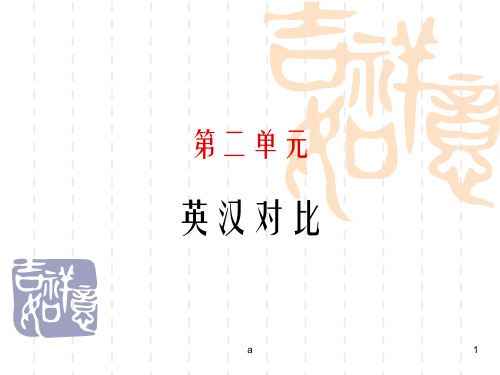
英汉对比
a
1
2.1 英汉语言对比
▪ 吕叔湘先生曾经指出:“只有比较才能看 出各种语文表现法的共同之点和特异之点。 拿外语跟汉语进行比较,可以启发我们注 意被我们忽略过去的现象。”
▪ 世界上每一种语言都有自己的语法,否则, 人们就不能进行翻译实践和翻译理论的研 究。而通过分析和对比英汉两种语言,译 员必将更加深刻地体会到译事之艰辛。
2. Upon his death in 1826, Jefferson was buried under a stone which described him as he had wished to be remembered as the author of the Declaration on Independence and the Virginia Statute for Religious Freedom and the father of the University of Virginia.
a
7
2.1.2 形合与意合
▪ 英语国家沿袭了古代希腊人非常严格和规范的语 词系统。古代希腊人认为,语词系统与思维系统是 相一致的,要表达一个清晰合理的思想就离不开清 晰合理的词形和句法。而在一个毫无条理的陈述 结构中,思想肯定也是杂乱无章的,而杂乱无章的 思想是没有意义的。英语形合的特征正是在这样 一种背景之下形成的。
a
16
参考译文
1. 月球离地球非常遥远,即使那边山上长着 大树,有大象在跑来跑去,我们用已经发 明的最高倍率的望远镜也不能看到它们。
2. 1826年杰斐逊逝世。按他生前遗愿,在他 墓地的石碑上刻着:独立宣言和弗吉尼亚 州信教自由法令的作者,弗吉尼亚大学创 建人之墓。
[英语学习]翻译理论与实践
![[英语学习]翻译理论与实践](https://img.taocdn.com/s3/m/99dcc22e0912a216147929cd.png)
2. The Relationship between Translation Theory and Techniques (Practice)
Those who can, translate; those who can't, teach translation; those who can't teach translation, teach translation theory. Those who can, write; those who cannot, translate; those who cannot translate, write about translation.
See TB P19
Enjoyment
广告之后更精彩
成都家教,成都家教网;
优乐美
Elegant, Happy & Beautiful U.loveit U.loveme
成都家教,成都家教网;
The definition is:
Translation is a rendering from one language into another, i.e., the faithful representation in one language of what is written or said in another language.
The Relationship between Translation Theory and Techniques
• Translation theory refers to the laws to help people to understand the laws and solve different kinds of problems in translation, while translation techniques refer to the experience people have accumulated in their practice of translation. Techniques are important, but they are not panacea. Different kinds of materials to be translated require different stresses in their rendition. For example, scientific materials stress their preciseness, novels and stories, their plots and characters, etc. We must master the translation theory to guide our translation work. (the teacher’s opinion) • In the point view of Eugene A. Nida, the famous American translator, “translation practice without an adequate theory produces only haphazard results, while theory without practice is completely sterile” (Nida, 1969).
翻译理论与实践[汉译英]汉英翻译new
![翻译理论与实践[汉译英]汉英翻译new](https://img.taocdn.com/s3/m/c9c977bfd15abe23482f4db5.png)
[例3] 这家机构因公正在国际上享有声誉 (名词) [译文] The agency enjoys an
international reputation for impartiality.(名词)
[例4] 玛丽铺上一块洁净的白桌布,又去取来些 葡萄。 (动词)
[译文] Mary unfolded a clean white table cloth and went to fetch some grapes.(动词)
[例1] 如果谷物收成不好,将会出现严重的粮荒。 [译文] If the crops fail there will be a serious food
shortage. [例2] 他朝它开了枪,但未射中。 [译文] He shot at it, but missed.
3)形容词和形容词短语:few, little, free from, far from, safe from, short of等等。
办公场地,闲人勿进。
乱发 (正说) ragged hair(正说) uncombed hair (反说)
冷酷的心(正说) stony heart(正说) remorseless heart(反说)
非同寻常(反说) out of the ordinary(正说) unusual (反说)
5) 连词:unless, before, until, (rather) than, or 等等。
[例1] 如果政府不同意提供更多的资金,这剧院 将不得不关闭。
[译文] Unless the government agrees to give extra money, the theatre will have to close.
翻译理论与实践(英译汉)3
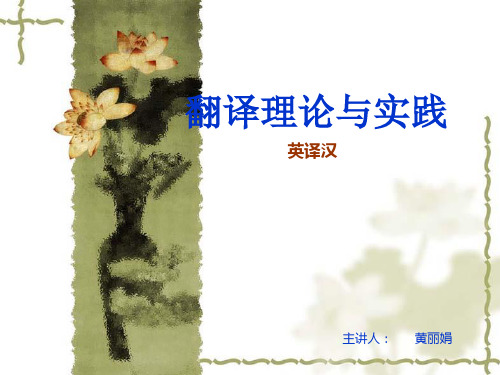
2. Lexical difference 词法差异
1. tenses, voices and moods 时态、语态和语气 动词在英汉两种语言中都起着举足轻重的作用,但英语动词远比 汉语动词复杂多变。首先,汉语不像英语那样具有屈折形态变化, 而是靠形态助词粘附(xation)和词的重叠、组合(repetition and combination)表示形态变化。英译汉时,就需要将英语以屈 折形态变化表示的意义转换成汉语的词汇意义,即采用增词法。 例如时态可通过增加“着、了、过、正在” 等词表示;被动语态 可通过增加“被、遭、为、由”等词表示;语气可通过增加“了、 的、吗”等表示。 a. The criminal was hanged. b. Clark used to be an army officer, but he is in prison now. c. Hadn’t the dam been built, there would have been a terrible flood.
2. at orthographic level 文字系统
英汉语言的差异首先表现在文字系统上。文字系统是语言 的视觉符号系统(system of visual signs of language), 文字系统充分地体现了语言的异质性。汉语属表意文字系 统(ideographic),英语属拼音文字系统(alphabetic), 汉语与英语属于截然不同的两个文字系统。
3. Syntactical difference 句法差异
The most important difference between the two languages lies in _________ and parataxis hypotaxis _________.
翻译理论与实践教学课件
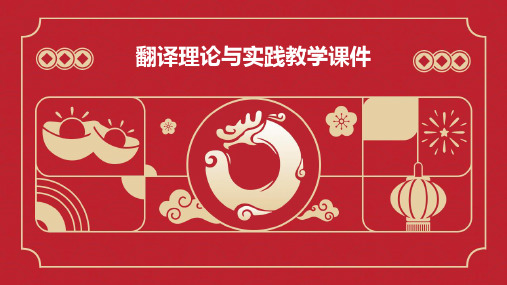
02 翻译技巧与实践
CHAPTER
理解与表达
理解
准确把握原文含义,包括词汇、语法 、语境等,是翻译的基础。
表达
将理解后的信息用目标语言表达出来 ,要求准确、流畅、符合目标语言习 惯。
直译与意译
直译
按照原文的词句、结构进行翻译,保留原文形式和意义。
意译
不拘泥于原文形式,以传达原文意义为主,更注重译文的流畅性和自然度。
03 翻译教学策略与方法
CHAPTER
翻译教学目标的设定
提高学生翻译技能
01
通过系统的翻译训练,帮助学生掌握基本的翻译技巧和方法,
提高翻译水平。
培养跨文化意识
02
引导学生理解不同文化背景下的语言差异,培养跨文化交流的
能力。
培养职业道德素养
03
强调翻译的准确性和规范性,培养学生的职业道德素养和责任
04 翻译实践案例分析
CHAPTER
文学翻译案例
总结词
注重语言艺术和文化内涵
VS
详细描述
文学翻译案例主要涉及诗歌、小说、戏剧 等文学作品,强调语言的美感和文化内涵 的传递。在翻译过程中,需要关注原文的 艺术风格、修辞手法和情感色彩,力求在 译文中保留原作的艺术魅力。
商务翻译案例
总结词
注重专业性和准确性
采用传统的讲授、练习和讨论相结合 的教学方法,确保学生掌握基本的翻 译知识和技能。
案例教学法
通过分析真实的翻译案例,让学生了 解实际翻译过程中遇到的问题和解决 方法。
合作学习法
组织学生进行小组合作,共同完成翻 译任务,培养学生的协作能力和团队 精神。
信息技术应用
利用现代信息技术手段,如在线学习 平台、智能翻译软件等,提高教学效 率和学生的学习效果。
week 3
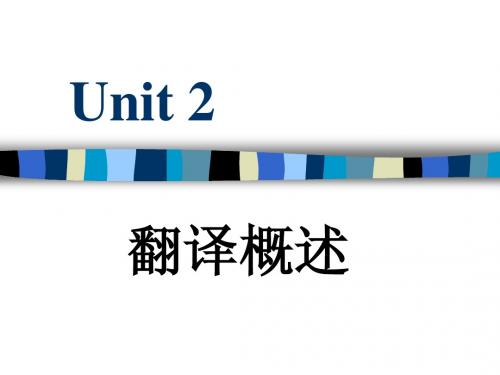
二、以作者和读者为取向的翻译原则(the author-andreader-oriented translation principle)。 这一原则既考虑到作者又同时考虑到读者,比较全面。 十八世纪末的英国学者亚历山大•泰特勒(Alexander Fraser Tytler,1747-1814)在《论翻译的原则》(Essay on the Principles of Translation)一书中提出了著名的 翻译三原则: (1)译文应完全复写出原作的思想(A translation should give a complete transcript of the ideas of the original work.) (2)译文的风格和笔调应与原文的性质相同(The style and manner of writing should be of the same character as that of the original.) (3)译文应和原作同样流畅(A translation should have all the ease of the original composition.)
1.翻译就是翻译意义(Translation means 翻译就是翻译意义( 翻译就是翻译意义 translating meaning.)。 )。 意义分为1)指称意义(linguistic meaning)、 意义分为 指称意义( )、 指称意义 2)言内意义(linguistic meaning)和3)语用 言内意义( 言内意义 ) ) 意义( 意义(pragmatic meaning)。 )。 指称意义是语言符号和它所描绘或叙述的主观 指称意义 世界或客观世界的实体和事件之间的关系,是 词语、句子和篇章所反映的客观世界。例如: father (父亲),table cloth(桌布),The sun rises in the east.(太阳从东方升起。)
翻译理论与实践.doc
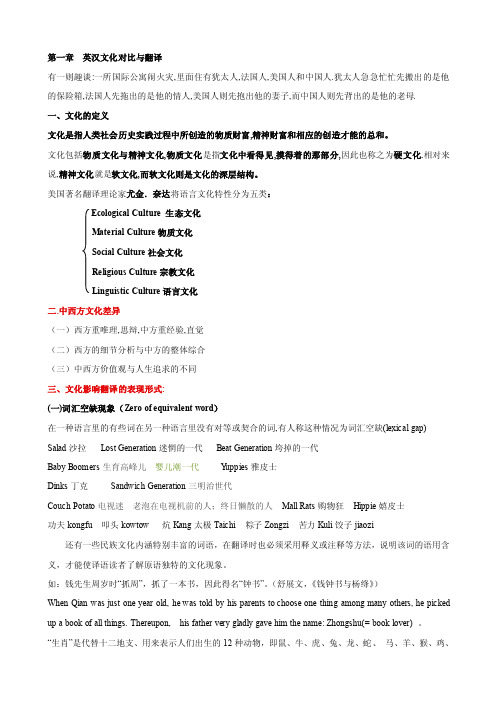
第一章英汉文化对比与翻译有一则趣谈:一所国际公寓闹火灾,里面住有犹太人,法国人,美国人和中国人.犹太人急急忙忙先搬出的是他的保险箱,法国人先拖出的是他的情人,美国人则先抱出他的妻子,而中国人则先背出的是他的老母.一、文化的定义文化是指人类社会历史实践过程中所创造的物质财富,精神财富和相应的创造才能的总和。
文化包括物质文化与精神文化,物质文化是指文化中看得见,摸得着的那部分,因此也称之为硬文化.相对来说,精神文化就是软文化,而软文化则是文化的深层结构。
美国著名翻译理论家尤金.奈达将语言文化特性分为五类:Ecological Culture 生态文化Material Culture物质文化Social Culture社会文化Religious Culture宗教文化Linguistic Culture语言文化二.中西方文化差异(一)西方重唯理,思辩,中方重经验,直觉(二)西方的细节分析与中方的整体综合(三)中西方价值观与人生追求的不同三、文化影响翻译的表现形式:(一)词汇空缺现象(Zero of equivalent word)在一种语言里的有些词在另一种语言里没有对等或契合的词,有人称这种情况为词汇空缺(lexical gap) Salad沙拉Lost Generation迷惘的一代Beat Generation垮掉的一代Baby Boomers生育高峰儿婴儿潮一代Y uppies雅皮士Dinks丁克Sandwich Generation三明治世代Couch Potato电视迷老泡在电视机前的人;终日懒散的人Mall Rats购物狂Hippie嬉皮士功夫kongfu叩头kowtow 炕Kang太极Taichi粽子Zongzi苦力Kuli饺子jiaozi 还有一些民族文化内涵特别丰富的词语,在翻译时也必须采用释义或注释等方法,说明该词的语用含义,才能使译语读者了解原语独特的文化现象。
如:钱先生周岁时“抓周”,抓了一本书,因此得名“钟书”。
翻译理论与实践概述
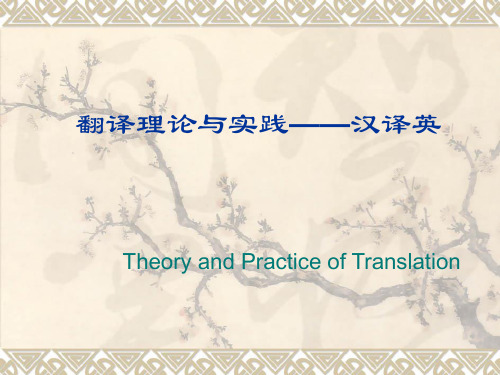
Definitions of translation (1)
According to Nida (1959:19) translation is “producing in the target language the closest natural equivalent of the source language message, firstly with respect to meaning and secondly with respect to style (Nida 1959: 19). In the tradition of skopos theory Nord (1997: 36) wrote: “The Skopos of the translation determines the form of equivalence required for an adequate translation”
From Sense and Sen不見人, 但聞人語響。 返景入深林, 复照青苔上。
Empty mountains: no one to be seen. Yet—hear— human sounds and echoes. Returning sunlight enters the dark woods; Again shining on the green moss, above. Translated by Gary Snyder
Translation sub-competences (5)
Transfer
competence This entails the ability to produce target texts that satisfy the demands of the translation task; including the ability to negotiate and collaborate with other translators and subject matter experts to accomplish the task at hand, i.e., the social aspects of the translation event
翻译理论与实践 unit 3 sentence
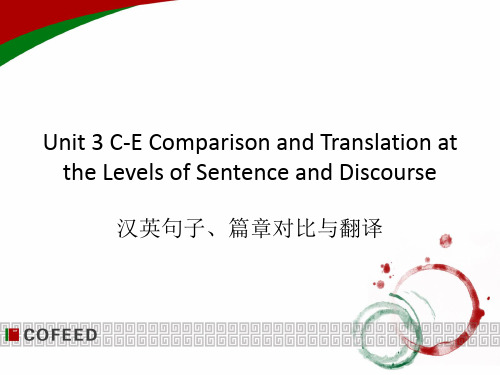
Think about it.
• 外廓城是居民的住宅区和商业区, 它由南北十一条街和东西十四条街 划分为一百零八坊和东市、西市两 个商业区。长安城布局状如棋盘。
【2004年8级测试汉译英】
• ①在人际关系问题上我们不要太浪漫主义。 ②人是很有趣的,往往在接触一个人时首 先看到的都是他或她的优点。③这一点颇 像是在餐馆里用餐的经验。④开始吃头盘 或冷碟的时候,印象很好。⑤吃头两个主 菜时,也是赞不绝口。⑥愈吃愈趋于冷静, 吃完了这顿宴席,缺点就都找出来了。⑦ 于是转喜为怒,转赞美为责备挑剔,转首 肯为摇头。
We have integrated IT market resources, striving to be specialized and market-oriented with scale and standardization.
• 9. 到了济南府,进得城来,家家泉水, 户户垂杨,比那江南风景,觉得更具为 有趣。 • When he reached Jinan and entered the city, there were flowing streams by every house and willow trees by every door, which delighted him even more than the scenery of the south. (刘鹗《老残游记》, 杨宪益、戴乃迭译)
• 14. 他踌躇了一会,终于还是决定自己送我 去 • 15. 我再向外看时,他已抱了朱红的橘子望 回走。 • 14. But after much hesitation he finally decided to see me off himself. • 15. When next I looked out he was on his way back with some ruddy tangerines.
汉英英汉翻译理论与实践
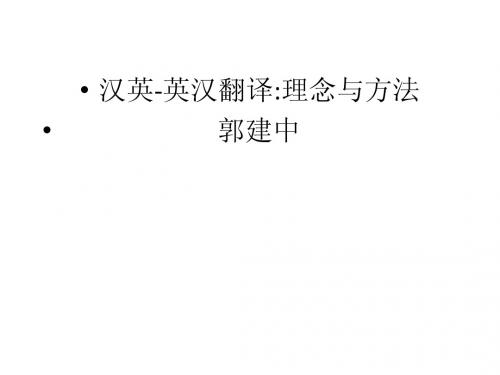
余光中先生也谈到 :“一个人的翻译 , 其实就 是他自己翻译理念的实践, 正如一个人的创作 里其实隐藏了自己的文学观。”(余光中, 2002 :196) 上述论述, 也证明了翻译观与翻译技巧, 或者 说是翻译的理念与翻译的方法有着密切的联系。 正如刘宓庆先生所说 :“认识的深化 , 只有在 方法论的指导下, 从事脚踏实地的研究和实践 才能获得。这是方法论和认识论的统一, 也就 是翻译理论与翻译实践的统一。”(刘宓 庆,2001 : 94)
• Catford: ”Translation is the replacement of textual material in one language ( SL ) by equivalent textual material in another language (TL) . ”(Catford , 1965: 20) • Nida: “Translating consists in reproducing in the receptor language the natural equivalent of the source language message, first in terms of meaning and secondly in terms of style.”(Nida and Taber , 1982 : 12) • 法国释意派对翻译下的定义是: • Delisle: “Translation is an art of re-expression based on writing techniques and a knowledge of two languages. ” (Delisle, 1980: 3)
• 傅雷:“但是我们在翻译的时候, 通常总是 胆子太小, 迁就原文字面、原文句法的时 候太多。要避免这些, 第一要精读熟读原 文, 把原文的意义、神韵全部把握住了,才 能放大胆子。”(转引自怒安, 2005 :29) • 思果: “切不可译字, 要译意, 译情, 译气势, 译作者用心处。记住, 译者最大的敌人是 英文字。”(思果, 2001a : XXI)
翻译理论与实践

通过众包平台邀请多人对译文进行评估,以获得更全面、客观的评估结果。众包评估可以降低成本,提 高效率,但需要注意评估人员的专业性和质量控制。
提高翻译质量的途径
提高语言能力
加强源语言和目标语言的学习,提高语言水平, 包括词汇、语法、句式和修辞等方面的能力。
掌握翻译技巧
学习和掌握各种翻译技巧和方法,如增译、减译 、转译、分译等,以提高翻译的准确性和流畅性 。
文化传递
在翻译过程中注意文化的传递,尽可能保留 原文的文化特色,同时考虑目标读者的文化 接受度。
03
翻译质量评估标准与方法
翻译质量评估标准介绍
01
02
03
准确性
译文是否准确传达了原文 的含义,包括词汇、语法 、句式和修辞等方面的准 确性。
流畅性
译文是否通顺流畅,符合 目标语言的表达习惯,易 于理解和接受。
翻译理论与实践
汇报人:XX
目 录
• 翻译理论概述 • 翻译实践技巧探讨 • 翻译质量评估标准与方法 • 机器翻译技术与应用前景 • 口译实践与技巧分享 • 翻译行业现状与未来发展趋势
01
翻译理论概述
翻译的定义与本质
翻译的定义
翻译是将一种语言中的文本转换成另 一种语言中的等效文本的过程,涉及 语言、文化、交际等言的文化背景,包括历史 、文化、社会、政治等方面的知识,以避免文化 冲突和误解。
使用辅助工具
利用计算机辅助翻译(CAT)工具、机器翻译( MT)工具等辅助工具,提高翻译效率和质量。同 时需要注意对辅助工具的使用方法和局限性有充 分了解。
04
机器翻译技术与应用前景
机器翻译技术原理简介
翻译行业面临的挑战与机遇
挑战
翻译理论与实践(全套)精品PPT课件
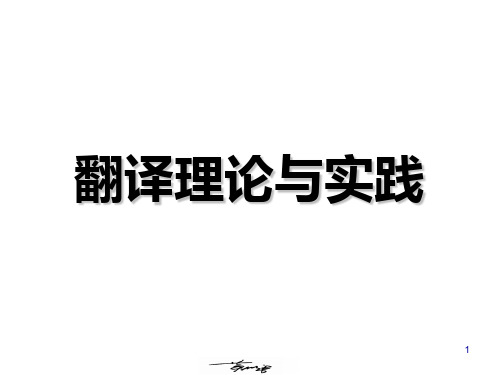
导学——课程要求
Tests: 60% There will be only one test: a final. But there may also be
Main Language points: 1. Comparative studies of language family 2. Comparative studies of word building in English and
Chinese 3. Comparative studies of syllable
Exercise
5
第三章:词语的翻译
教学目的:旨在帮助学生了解词义的多样性 (引申、褒贬);并掌握词语翻译的选词技巧。
教学内容: 1. 词义的选择 2. 词义的引申 3. 词义的褒贬 4. 翻译练习
6
第四章:句子翻译技巧(上)
一、教学目的:要求熟练理解句子的翻译技 巧,从而在英汉翻译时做到通顺、准确。
教学内容: 1. 翻译的定义、分类 2. 翻译的标准 3. 翻译的过程:理解——表达——校对 4. 中、西译史
练习
4
第二章:英汉语言现象对比
Teaching aims: to learn about the similarities and differences of Chinese and English in word forming and vocabulary so as to translate them accurately.
二、教学过程:
1. 增译法 2. 省译法 3. 词类转换 4. 正说反译、反说正译法 5. 翻译练习1、2、3、4
7
第五章:句子翻译技巧(下)
一、教学目的:要求熟练理解句子的翻译技 巧,从而在汉英翻译时做到通顺、准确。
《翻译理论与实践》课件

语言中蕴含的情感色彩是语用意义的重要组成部分,译者需要关注原文的情感色彩,并在译文中进行适 当的表达,以实现语用意义的完整传递。
语用等效与翻译策略
语用等效原则
在翻译过程中,译者应遵循语用等效原则,确保译文在目 标语言中产生与原文相同的效果,包括语言功能、语用意 义和修辞效果等方面。
翻译策略的选择
总结词
遵循法律文件的严谨性
详细描述
商务合同的翻译实践需遵循法律文件的严谨性。译者应仔 细核对原文,确保译文的准确性和完整性,避免因疏忽而 产生的法律风险。同时,在遇到法律术语时,译者应进行 深入研究,确保译文的准确性和专业性。
新闻报道的翻译实践
总结词
时效性是新闻报道的生命线
详细描述
新闻报道的翻译实践要求时效性极强,因为新闻报道需要 及时传递给目标语读者。在翻译过程中,译者应快速准确 地完成翻译工作,确保新闻报道的时效性不受影响。
为实现语用等效,译者需要根据具体情况选择合适的翻译 策略,如直译、意译、增译、减译等,以准确传达原文的 语用意义。
语用等效的评价
评价译文是否达到语用等效,需要考虑译文在目标语言中 的可接受度、表达的自然度以及读者反馈等因素,以确保 翻译质量。
05
翻译中的语言规范与风 格
语言规范与翻译
语言规范
在翻译过程中,需要遵循目标语言的语法、词汇和表 达习惯,以确保译文准确、流畅。
VS
异化
以源语文化为归宿,保留原文的异国情调 和文化特色,让译文读者了解不同文化。
增译与减译
增译
在翻译过程中,根据目标语的语言习惯和表达方式,增加一些词语或短语,以使译文更加完整、流畅 。
减译
在翻译过程中,删减原文中一些不必要的词语或短语,使译文更加简洁、明了。
翻译理论与实践(TranslationtheoryandPractice)
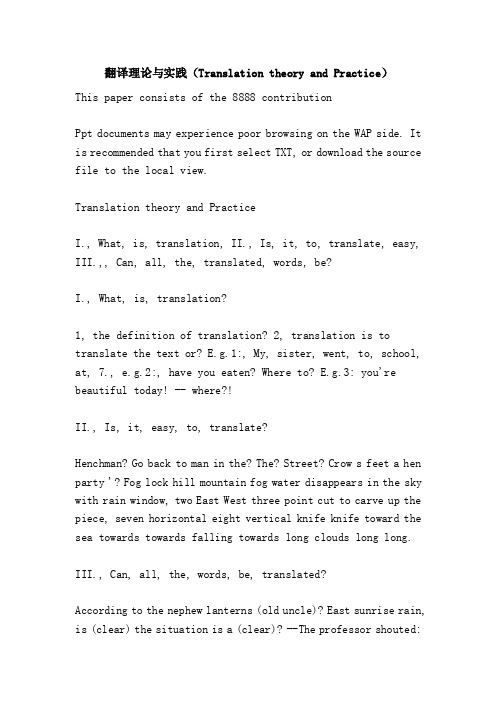
翻译理论与实践(Translation theory and Practice)This paper consists of the 8888 contributionPpt documents may experience poor browsing on the WAP side. It is recommended that you first select TXT, or download the source file to the local view.Translation theory and PracticeI., What, is, translation, II., Is, it, to, translate, easy, III.,, Can, all, the, translated, words, be?I., What, is, translation?1, the definition of translation? 2, translation is to translate the text or? E.g.1:, My, sister, went, to, school, at, 7., e.g.2:, have you eaten? Where to? E.g.3: you're beautiful today! -- where?!II., Is, it, easy, to, translate?Henchman? Go back to man in the? The? Street? Crow s feet a hen party '? Fog lock hill mountain fog water disappears in the sky with rain window, two East West three point cut to carve up the piece, seven horizontal eight vertical knife knife toward the sea towards towards falling towards long clouds long long.III., Can, all, the, words, be, translated?According to the nephew lanterns (old uncle)? East sunrise rain, is (clear) the situation is a (clear)? --The professor shouted:Gentlemen, order --The entire class yelled:! "" Beer! "--Why is the river very? Rich? --Because it has two banks.You can cage a swallow, but you can t swallow a "cage. --The secret is going to? Be exposed, and we ll look pretty silly. --You" already look pretty and silly. bathing on bikini? Girl, eyeing, boy, finds boy eyeing bikini on bathing girl.Chapter 1The definition of translation, the purpose of translation, the type of translation, the standard of translation, the process of translation, the conditions for translationDefinition of translationTranslation is the practice of language in which the content of another language is re expressed in one language. Feng Qinghua? Translation is a kind of language (i.e., primitive) information in another language (the target language) express, so that the readers can get the original thoughts expressed by the author, are roughly the same as the original readers feel. - Fan Zhongying, translation is the translator's re understanding of the same thing and the use of another text. - Qiao HaiqingDefinition of translationTranslation is "an interpretation of verbal signs by means of some other language Translation is." Jakobson? "The replacement of textual material in one language (SL) byequivalent textual material in another language (TL). Catford Translation is the replacement of? A representation of a text in one language by a representation of an equivalent text in a second language. HudsonThe purpose of translationA bridge of communication and communication between different languages and cultures.Types of translationIntra language translation (intralingual translation) an interpretation of verbal signs by means of other signs in the same language (interlingual translation) translation? An interpretation of verbal signs by means of some other language? Intersemiotic translation (intersemiotic translation) an interpretation of verbal signs by means of nonverbal signs systemChinese translation theoriesYan Fu: Xindaya translation - Three: xindaya. It is hard to ask for a letter. Take care of the letter and fail to reach it,Even if you do not translate it, you will also interpret it. ? Lu Xun: faith, Shun - a course to make it easy, one is to preserve the original charm. / / faith rather than fluency? Qu Qiubai: the notion of equivalence translation should be the original intention, exactly China introduced to readers, make readers get China concept concept equal to other language from the textto the reader. Contradiction: to reproduce the artistic conception the highest task of literary translation is to reproduce the artistic conception so that the target readers can enjoy the beauty as much as the original.Chinese translation theoriesLiu Zhongde: letter, reach, cut letter: believe in content: as long as it is cut: to adapt to style, Zhang today: true, good, beautiful, truth: truth, principle, good: ideological principles: Beauty: artistic principlesForeign translation theoriesTytler: 1. The translation should the same effect on give a complete transcript of the ideas of the original work. style and manner of 2. The writing should be of the same character as that of the original. translation should have all 3. The the ease of the original composition.Federov: on Translation should produce a translation version which may be read with as much pleasure as the original, and yet remain faithful to its spirit, sense and style. Nida: dynamic equivalence theory readers get responses, and feelings with the original readers read the original income roughly equal. Newmark: text centered theoryProcess of translationIt is generally believed that the original text is understood expression Nida: original text testAnalytical translationTarget textRestructureFour steps: analysis, translation, reconstruction, testTranslation, from, English, to, Chinese:1., The, days, run, into, weeks., the days go by, for a few weeks.2. It, s, all, Greek, to, me., the translation condition, I do not understand at all. Mandarin Chinese is better than3. Mary has? A clever tongue. Marie (glib glib). English language ability is better than4., You, can, never, tell., wide knowledge, no one can say.5., My, memory, failed, me, at, that, moment., I can't remember that moment.6., Your, name, obstinately, escapes, me., I can't remember your name.7., To, think, that, you, should, fail., I don't think you will fail. 8., Would, it, were, otherwise, if that's not the case. There was more mischief than harm in him. he is only mischievous, and no harm. 10., I, never, go, past, my, old, school, but,, think, of, our, headmaster.. Every time I pass my alma mater, I remember our headmaster. 11., The, book, is, beyond, me., I can't read this book. 12., There, is, nothing, like, leather, for, shoes., leather shoes are great. 13., It, is, too, recent, to, be, forgotten., fresh in memory.14., The, mountain, is, not, valuable, because, it, is, high.,mountain is precious, not at its height. The "This is the last place I where expected to meet you." did not expect to meet you here. 16., He, is, nothing, if, not, stubborn., he's a stubborn man. 17., I, was, not, a, little, surprised., I was shocked.18., He, can, do, it, if, any, one, can., only he can do it.19. You cannot make something out of nothing. one can't make bricks without straw. 20., I, can, t, bear, the, sight,, of, that, man.I can't stand seeing that man.Similar sentences1. He had made a box., he has made a box. He had a box made., he told people to make a box.2. Foolishly he spoke. he was so foolish to speak. He spoke foolishly. he talks very stupid.3. Quite properly he was punished. he deserved to be punished. He was punished quite properly., he was properly punished.4., We, asked, him, to, speak, from, his, experience., we ask him to talk about it based on his experience. We asked him to speak about his experiences. we asked him to talk about his experience.Similar sentences5. He is behind time. he's late. He, is, behind, the, times., he's behind the times.6. His success is out of question. his success is beyond doubt. His, success, is, out, of, the, question, he's never going to be successful.7., They, went, to, sea., they're going to besailors. They, went, to, the, sea., they went to the beach. 8., It, has, been, raining, continually, for, two, days., rain, intermittent two days. It has, been, raining, continuously, for,, two, days rain continued for two days.Similar sentences9., He, has, no, more, than, ten, books., he has only ten books. He has not more than ten books., he has ten books at most.He is not a little afraid of it. he was very scared. He is not a bit afraid of it., he is not afraid at all. 11., I, didn, t, go, because, I, was, afraid., I am not afraid to go. I, didn, t, go, because, I, to., was, afraid, I did not go, because I dare not go. 12. She kept the house., she watches over the house. She kept house. her home.Similar sentences13., This, is, no, place, for, me, to, go., this is not whereI should go. There, is, no, place, for, me, to, go, I have nowhere to go. 14. I, had, a, good, talk, to, him, yesterday., I gave him a good dressing down yesterday. I had a good talk with him yesterday. I had a really good time talking to him yesterday. 15., Tom, escaped, prison., Tom escaped the jail. Tom, escaped, from, prison., Tom, jailbreak. 16., Is, there, any, difficulty, in, this? Do you have any difficulty with this? Is, there, some, difficulty, in, this? It's a bit difficult, isn't it?Similar sentencesWe are sure that man is mortal. we are sure that man will always die. We, are, sure, that, man, is, dead., we are sure the man is dead. 18., We, hired, the, boat, by, the, hour.. We ship by hour. We hired, the, boat, for, an, hour., we rented an hour boat.Similar sentences19., I, did, not, notice, him., I didn't notice him. I, took, no, notice, of, him., I don't care about him. 20., Happily, he, did, not, die., thankfully he did not die. He did not die happily., he died uneasy.The second chapter is semantic translationFirst, the choice of meaning in the understanding of polysemy (polysemy)The translation of runRun, a, car, run, shop, run, oil, run, message, a, fever, run, a, computer, run, run, a, meeting, run,, chickens, run, a, arms, advertisement, run, anHead translation10. He arranged his speech under five heads. his speech is divided into five parts. 11., We, have, thirty, head, of, cattle.We have thirty cows. 12., Heads, or, tails? Heads or tails? 13., Where, is, the, head? Where is the toilet?The translation of head:1. head of the English Department, director of the English Department of2. head of the government head of the bed, head of government3.4. head of the staircase a of the needle at the top of the stairs5. head6. He was badly wounded in a the head. he was badly wounded in the head.7. He has a good head for maths. he has a lot of mathematical talent.8., You, should, use, your, head., you should use your head.9. The, dinner, cost, US, five, dollars, a, head., the meal cost us 5 yuan each.The translation of I. poor:1. The, cloth, is, poor, in, quality., this cloth is of poor quality.2. The, water, is, poor, in, oxygen., this water is anoxic.3. Her first concert had a poor audience., her first concert, with very few listeners.4. This, to, her, was, a, poor, consolation., this comfort does not work for her.5. In my poor opinion, you should let her go. in my humble opinion, you should let her go. Boat. She was a poor sailor and always went to bed immediately on on getting the she has seasickness problems, so always go to bed on board.The translation of II. runThe He will not be running in the next election., he is not ready to run for the next election. 2., The, train, is, not, running, today., that train is off today. 3. The film began to run. filmat the. 4. His face was running with sweat. he Sweat streamed down the face. 5., It, was, such, a, ran., hot, day, that, the, butter, the weather was so hot that the butter melted. 6., The, road, runs, north., this road extends north. The "The rumor runs that he is going to resign." is rumoured that he is going to resign. 8., The, monsoon, had, six, weeks, more, to, run., the rainy season will last six weeks.The translation of II. run9., The, car, repair, will, run, you, at, least, two, hundred., repair, at least you spend two hundred yuan. 10. The play ran for only a week in that theatre.. The play was only staged for a week in that theater. 11., Potatoes, are, running, large, this, year., potatoes grow a lot this year. 12., A, freezer, doesn, run., t, cost, much, to, the use of the refrigerator is not very expensive.The translation of III. liveShe needs to find somewhere to live. she needs to find a place to live. 2., Where, do, these, plates, live? Where are these dishes? 3., Spiders, can, live, for, several, days, without, food., spiders can live without food for a few days. 4., We, saw, a, real, rattlesnake, live! We saw a live rattlesnake.The translation of III. live5. The club has live music most nights., the club has live music most nights.6. The show is going on live., the show is being broadcast live.7., Pollution, is, still, very, much, a, live,issue. pollution is still a very interesting issue at the moment.8., This, is, a, live, and, interesting, book., this is a lively and interesting book.The translation of IV. like1., He, likes, mathematics, more, physics., than, he prefers mathematics to physics.2., Bananas, don, t, like, me., I ate a banana and my stomach was upset. (bananas do not fit my stomach.) Three它的味道像芒果。
英汉翻译技巧week 3

• C. Expression: try to express the meaning in idiomatic Chinese; • D. Revision: (proofread) check again and again to polish the language.
• • • •
He is employed in watering the garden. 他被雇来浇花。 他忙于浇花。 He is not a majestic personal figure like Roosevelt, and he doesn’t inspire fear like Jonson. • 和罗斯福一样,他不是一个代表威严的人物,和约翰 逊一样他也不会让人望而生畏。 • 他并不像罗斯福是一个代表威严的人物,也不像约翰 逊那样让人望而生畏。
• 例5.The bear rounded and faced the hunters. • 那熊转过身来对着猎人们。 • When you pronounce the vowel [u:], round your lips. • 发元音[u:]时,要双唇收圆。
★ To determine the meaning of words
according to the fields of the study
• Power can be transmitted over a long distance. • 电力可以输送到很远的地方。 • Energy is the power to do work. • 能是做工的能力。 • Friction causes a loss of power in every machine. • 摩擦能引起每台机器的功率损耗。
words according to parts of speech
英汉翻译理论与实践

分句法与合句法
分句法
分句法是指将英文中的一个长句拆分成 两个或多个短句进行翻译,以使译文更 加符合汉语的表达习惯。例如,“He is a good singer and dancer”可以拆分 成“他是一个好歌手”和“他是一个好 舞者”。
VS
合句法
合句法是指将英文中的两个或多个短句合 并成一个长句进行翻译,以使译文更加流 畅、紧凑。例如,“She is a doctor and she is also a writer”可以合并翻译 为“她既是一名医生,也是一名作家”。
意译
意译是按照原文的含义和精神进行翻译,不拘泥于原文的词序和结构。在意译时,需要摆脱原文的语 言束缚,用自然、流畅的语言表达原文的含义,同时保持译文的完整性和连贯性。
增译与减译
增译
增译是指在翻译过程中,根据原文的含义和语境,增加一些 必要的词语、短语或句子,以使译文更加完整、流畅和准确 。增译通常用于弥补原文的省略、补充背景信息、解释文化 概念等。
句子结构问题
总结词
句子结构问题是英汉翻译中的重要问题之一。
详细描述
由于英汉两种语言的句子结构存在较大差异,因此在进 行英汉翻译时,需要进行必要的句子结构调整。例如, 英语中常用长句和复合句,而汉语中则常用短句和简单 句。在进行英汉翻译时,需要将英文的长句和复合句拆 分成汉语的短句和简单句,或者将汉语的短句和简单句 整合成英文的长句和复合句。
商务翻译
总结词
商务翻译涉及商业、法律、合同等领域的文 本,要求准确、专业、规范。
详细描述
商务翻译要求译者具备相关领域的专业知识 ,能够准确理解并表达原文的含义。在翻译 过程中,译者需特别注意语言的严谨性和规 范性,以确保译文的准确性和合法性。同时 ,商务翻译还强调译文的流畅性和易读性,
- 1、下载文档前请自行甄别文档内容的完整性,平台不提供额外的编辑、内容补充、找答案等附加服务。
- 2、"仅部分预览"的文档,不可在线预览部分如存在完整性等问题,可反馈申请退款(可完整预览的文档不适用该条件!)。
- 3、如文档侵犯您的权益,请联系客服反馈,我们会尽快为您处理(人工客服工作时间:9:00-18:30)。
Lecture 3 DictionBetter late than the late. (原文为美国高速公路上矗立的安全警示牌)Tension is building up.(l) This war is becoming the most important story of this generation.(2) It is quite another story now.(3) Some reporters who were not included in the session broke the story.(4) He’ll be very happy if that story holds up.(5) The Rita Haywoth’s story is one of the saddest.(6) A young man came to Scotti’s office with a story.(7) Last Dec. the Post first reported that probes were being made in each of those cities, but officials refused to confirm the story.(8) The story about him became smaller and by and by faded out from the American TV.3.1 Methods to Discriminate the Original Meaning of an English Word3.1.1 Judging from the Word Formation pneumonoultramicroscopicsilicovolcanoconiosis3.1.2Judging from the Part of SpeechRight,open your mouth,let me have a look.He hoped to be absolutely right about this issue.I must answer that phone,but I’ll be back right away.The ship righted itself after the big wave had passed.In England,we drive on the left side of the road,not the right side.He exercised his legal right as President to halt the investigation.3.1.3 Judging from the References1. I hate blue shirt; white shirt suits me but gray is the most preferable.3.1.4 Judging from the Context and Collocation1.Symptoms of SARS developed.2.We had hopes of developing light industry on quite a large scale.3.Land animals are thought to have developed from sea animals.4.The local government is planning to develop the western areas.5.The photographer develops all his films.6.I’d like to develop this idea a little more fully before I go on to my next point.7.Scientists have succeeded in developing many new plants.Another example “as luck would have it”.1.As luck would have it,no one was in the hotel when the explosion took place.2.As luck would have it,there was rain on the day of the camp.Try to translate the following sentences1. observe the behavior of birds.2. Do they observe Christmas Day in that country?3. He observed that we should probably have rain.4. The law obliges parents to send their children to school.5. They were obliged to sell their house in order to pay their debts.6. I’m much obliged to you.如:please ~ me by closing the door.Obliging neighbordelicate skindelicate porcelaindelicate upbringingdelicate livingdelicate healthdelicate stomachdelicate vasedelicate diplomatic questiondelicate differencedelicate surgical operationdelicate ear for musicdelicate sense of smelldelicate foodraise fearsraise vegetablesraise a familyraise the deadraise a fleetraise a monumentraise an embargo3.1.5 Judging from Different Branches of Learning and Specialties1. The lathe should be set on a firm base.2. As we all know,a base reacts with an acid to form a salt.3. A transistor has three electrodes, the emitter, the base and the collector.4. Line AB is the base of the triangle ABC.5. He is on the second base.3.2 Some Techniques Employed in Translating a Given English Word 3.2.1 DeductionStopoutcommunitychallenge3.2.2 Transplant·Microwave ·Supermarket ·Splashdown ·dataphone 3.2.3 Extension·bottleneck·brain trust·brain drain·It is more than transient everydayness.3.2.4 Substitution·to kill sb. as an example·Pleaser withhold the handout.·The same is not true with a mortal illness.3.2.5 Explanation·mindlessness·togetherness·swan song·a throwaway society3.2.6 Combination·so subtle and careful an observer·his mendacity and dishonesty·a grim and tragic Christmas·the body and mind cramped by noxious work3.2.7 Pictographic Translation·H-beam·O-ring·U-steel·V-belt·X-brace·Y-curve3.2.8 Transliteration·Wall Street·The Times·Pentium·Citroen·clone·Internet·hacker3.3 Extension of Word Meaning3.3.1 Conversion of Meaning1. The factors which are likely to influence investment spending do not stop here.2. Whether you like it or not, globalization is here to stay. We are not going to reverse the trend.3.3.2 Abstract Extension of Meaning1. Everybody has his smiles and tears.2. The technological process was then a newcomer in the U.S., so application was not numerous.3. He was a man to let his heart rule his head.4. The matter was finally settled under the table.5. He Hamleted at a chance and regretted for it.6. The canoe Titanicked on the rock in the river.3.3.2 Concrete Extension of Meaning1. The interest rates have see-sawed between 10 and 15 percent.2. Brain drain has been Kangding’s No.1 concern; as a matter of fact, it has been an epidemic in this area.3. There is a mixture of the tiger and the ape in the character of the imperialists.4. He was a tough proposition.3.3.3 Extension According to Idiomatic Way in Chinese1. So the swallow flew round and round her,touching the water with his wings,and making silver ripples.没有摩天大楼芝加哥和纽约以高楼林立而闻名,加利福尼亚则不可能如此。
